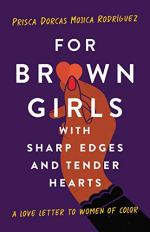|
This section contains 819 words (approx. 3 pages at 400 words per page) |

|
For Brown Girls With Sharp Edges and Tender Hearts Summary & Study Guide Description
For Brown Girls With Sharp Edges and Tender Hearts Summary & Study Guide includes comprehensive information and analysis to help you understand the book. This study guide contains the following sections:
This detailed literature summary also contains Topics for Discussion on For Brown Girls With Sharp Edges and Tender Hearts by Prisca Dorcas Mojica Rodriguez .
The following version of this book was used to create the guide: Rodríguez, Prisca Dorcas Mojica. For Brown Girls with Sharp Edges and Tender Hearts: A Love Letter to Women of Color. Hachette Book Group, 2022.
Prisca Dorcas Mojica Rodríguez's For Brown Girls with Sharp Edges and Tender Hearts: A Love Letter to Women of Color, is a nonfiction text tracing the author's first person encounters with racial violence and white oppression throughout her life. Although she asserts that the text is not a memoir, Rodríguez does write from her first person point of view and relies upon personal anecdotes to shape her overarching cultural and political commentaries. In her introduction, she explains that this formal approach is a way for her to contextualize more complex concepts, making them accessible to a wide range of BIPOC and BIWOC readers.
The following summary adheres to the text's overarching chaptered structure, and predominantly relies upon the present tense.
In the introduction, Rodríguez outlines her inspirations and goals for the text. She uses both the first person singular, first person plural, and the second person points of view in order to appeal to her reader. She asserts that her text might be a tool and a vehicle her reader can use to liberate and empower herself.
In Chapter 1, "Voluntourism," Rodríguez describes her experiences growing up in Nicaragua. She considers her encounters with groups of white beneficiaries. Although such groups did provide her family with helpful supplies and goods, they were engaging in a system of oppression. Voluntourism, she argues, is inherently violent, in that it disadvantages Brown communities and reinforces white saviorism.
In Chapter 2, "Colorism," Rodríguez traces the evolution of her relationship with her body. Throughout her childhood and coming-of-age, Rodríguez learned to be ashamed of her dark skin, her long, straight hair, her flat nose, and her body hair. As she grew up, however, she realized that her fraught relationship with her body was a direct result of colorism. Like many BIPOC, she had been taught to see herself as inferior. In the present, she identifies as a Brown woman, and has thus learned to feel pride in her racial and ethnic identities.
In Chapter 3, "Imposter Syndrome," Rodríguez first began to experience imposter syndrome when she moved to Nashville, Tennessee to pursue her graduate education. Because the town and school were predominantly white, Rodríguez felt unworthy of inhabiting these spheres.
In Chapter 4, "Myth of Meritocracy," Rodríguez argues that meritocracy is a lie and an illusion. The concept suggests that via hard work anyone can achieve anything they dedicate themselves to achieving. Rodríguez believes this theory was developed by the white, elite class, and is used to disadvantage BIPOC.
In Chapter 5, "Politics of Respectability," Rodríguez interrogates the concept of respectability politics. Respectability politics is the theory that BIPOC tailor their speech and behavior to survive and navigate white-centric spheres. Although code-switching may be a survival mechanism, Rodríguez holds that it stifles and suffocates BIPOC.
In Chapter 6, "Toxic Masculinity," Rodríguez describes her father's and brother's abusive behaviors towards her, her mother, and her sister. In order to understand their abuse, Rodríguez considers her father's and brother's trauma.
In Chapter 7, "Intersectionality," for years, Rodríguez felt ashamed of her body, her appearance, her voice, and her language. Once she realized that her identity was in fact an amalgamation of intersecting identities, she began to claim ownership of who she was and wanted to be.
In Chapter 8, "The Male Gaze," after Rodríguez's split from her first husband, she freed herself from the male gaze. Her friends helped her perform a ceremony to instigate this liberation. Over the months following, she inhabited herself anew by embracing promiscuity.
In Chapter 9, "White Fragility," Rodríguez considers the ways in which white fragility is both related to and more dangerous than racism. She presents a series of encounters with white fragility from her personal life. She implores her reader to foster connections with her fellow BIPOC and BIWOC in order to combat and overcome such behaviors.
In Chapter 10, "Decoloniality," Rodríguez analyzes the ways in which her elite education caused her to distance herself from her family, particularly her mother. Once she noticed the ways in which American systems of thought were endangering her relationships, she began to study decoloniality. Decoloniality is the idea that BIPOC must reclaim the power stolen from them from the white ruling class. Understanding and embracing decoloniality has allowed Rodríguez to renew her connections with her family, her culture, and her country.
In the conclusion, Rodríguez summarizes her overarching statements from the preceding chapters. She reminds her reader to use her text as a map and a tool. She also reinforces the importance of owning one's voice and identity, and of fostering communities of BIPOC and BIWOC in order to survive and combat white supremacy.
Read more from the Study Guide
|
This section contains 819 words (approx. 3 pages at 400 words per page) |

|



